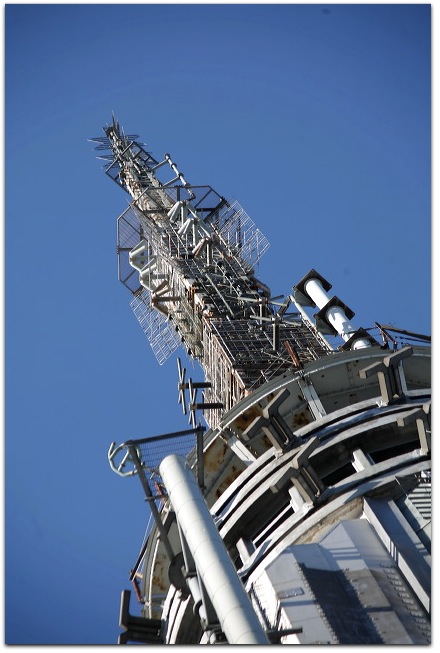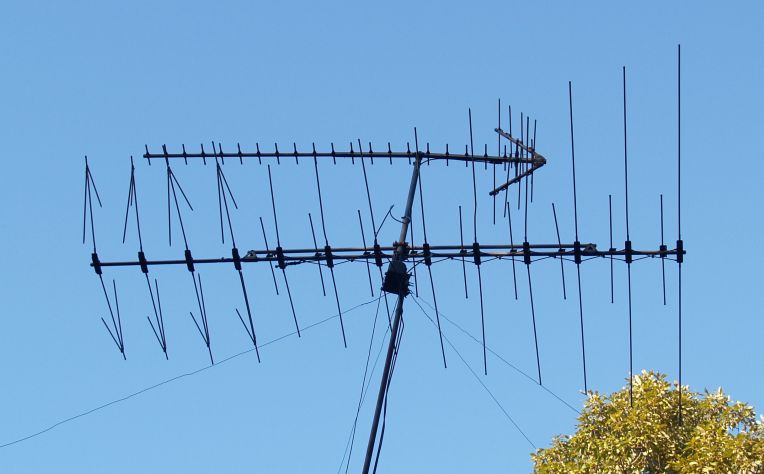
Aereo‘s main appeal in the first place was helping viewers get over-the-air TV. If they had restricted their business and legal cases to that, instead of this…
Record & Stream Live TV Online with Aereo Cloud DVR
Coming soon to 19 more cities!
… they might still be in business. But nothing in that pitch — the last one they made, in the final version of their website while they were operating — said they weren’t much different than a cable company. So, not surprisingly, the Supreme Court smacked them down for being a cable wolf in cloud wool. Here’s how the Court explained the decision:
The Copyright Act of 1976 gives a copyright owner the “exclusive righ[t]” to “perform the copyrighted work publicly.” 17 U.S.C. §106(4). The Act’s Transmit Clause defines that exclusive right to include the right to “transmit or otherwise communicate a performance . . . of the [copyrighted] work . . . to the public, by means of any device or process, whether the members of the public capable of receiving the performance . . . receive it in the same place or in separate places and at the same time or at different times.” §101.
I submit that Aereo failed because they didn’t stick with what they were for in the first place, which was selling you access to an antenna that got signals you couldn’t get with a loop or a rabbit ears jacked into your TV, they would have won. Instead, they decided to ride the “cloud” buzz, which confused the offering first and the Court second.
To understand how they might have won, you need some background.
Before the ’76 law, cable was called CATV, for Community Antenna TeleVision. CATV answered the market’s need for clear signals where reception of over-the-air signals was poor or absent. But once “cable networks” (TBS, HBO, ESPN, etc.) showed up, and it was obvious that the handful of legacy broadcast networks (ABC, CBS, NBC, PBS, Univision) would be outnumbered by new cable networks, those networks (and their programming sources) wanted to be paid by these new distributors, who were charging customers for retailing their goods (legally, “performances”). The ’76 law gave them leverage to force those payments.
Over-the-air (OTA) TV was still available for anybody to receive for free using an antenna, of course. But this was a legacy grace — an exception to the rule of closed distribution through cable and satellite. But the distinction was clear. Cable and satellite were Pay TV, and OTA was Free TV. The selection of free signals was (and remains) relatively small, but not much smaller than “basic” cable.
As the number of channels available on Pay TV climbed, the percentage of people watching free TV went down. From a Consumer Electronics Association report in July 2013:
Arlington, VA – 07/30/2013 – New research released today from the Consumer Electronics Association (CEA) ® found that just seven percent of American TV households rely solely on an antenna for their television programming. The findings of the new study, U.S. Household Television Usage Update, are consistent with CEA’s 2010 research which found eight percent of TV households reported using an antenna only for television programming. According to historical CEA research, there has been a gradual decline in the percentage of TV households using antennas since 2005. The phone survey of 1,009 U.S. adults is comparable to a 2012 Nielsen study indicating nine percent of all U.S. TV households are broadcast TV/over-the-air only, a decrease from 16 percent in 2003.
One reason for this is simply that there are more channels on cable than over the air. The other reason — the one that matters to Aereo — is that free TV reception nearly went away, thanks to the FCC’s mandated transition of OTA TV from analog to digital (DTV) transmission, which finished in June 2009.
For TV viewers, the DTV transition required new equipment to receive signals that were much harder to get. If you lived in any place shadowed from direct line-of-sight to signal sources, you were out of luck.
In the analog era, you could get signals with rabbit ears (for channels 2 to 13) and a loop or a bowtie antenna (for channels 14 and up) on your TV. The pictures might have “snow” or “ghosts,” but you could see them. If you lived in an outlying suburb or a rural area, you needed a rooftop antenna. If you lived where signals came from different cities in different directions, you used a directional antenna with a rotator. When I lived north of Chapel Hill, North Carolina in the late ’70s, the rotator on my TV looked like this:


Once all those stations went digital, however, nearly all of them disappeared. First, all low-band VHF stations (2 to 6) moved to UHF channels (14 and up), which by nature had far less range. Most of the high-band VHF stations (7 to 13) did the same, though some stayed in on their old channel or a different one. Then the feds began auctioning off the higher UHF channels, mostly to cell phone carriers. [Later, in 2023: after the last auction and “repack” in 2019, there were no TV stations in the U.S, transmitting above channel 36.] What your TV displays is just a “virtual” channel: its brand. The real channel is most likely different.
The FCC also claimed that signal range and coverage after the DTV transition would be “equivalent.” to what the old analog signals provided. This was bogus. Here are the FCC’s maps of “equivalent” coverage after the transition. The text on that page says, “Signal strength calculations are based on the traditional TV reception model assuming an outdoor antenna 30 feet above ground level. Indoor reception may vary significantly.” Two things there. First, “traditional” TV reception was probably mostly with rabbit ears. Second, in many cases new antennas were required: ones that favored the UHF and high-band VHF channels.
And the TV makers did their best to obsolesce what was left of OTA TV. They did this by substituting “scanning” for tuning. You had to navigate down a series of menus to find the setting where you scan for signals the TV would remember and put in your list of available channels. But, if your antenna was pointed west to get one bunch of signals, it would erase and forget those channels when you pointed your antenna east and scanned for another bunch of signals. Oh, and you needed to re-scan after stations changed the channels they transmitted on, which tended to happen after channels got auctioned off, and stations had to “repack” on what was left of the TV bands.
DTV signals also don’t degrade gracefully. They are there or gone. (When they do break up, it’s usually into a plaid pattern that doesn’t last long before the screen goes blank.)
So, thanks to all this, the DTV transition left millions of free TV viewers in the lurch — and that lurch was Aereo’s market. So here’s my point: There would have been no Aereo without the DTV transition.
In our apartment on the third floor of a building in the far north end of Manhattan, we get no TV signals at all, even with a directional outdoor antenna. Believe me, I’ve tried. There are a hundred blocks of buildings and terrain between us and the Empire State Building, where all the local TV transmitters are. If we want local over-the-air (OTA) TV, our only choice is — or was — Aereo.
By serving urban areas that got shafted by the DTV transition, Aereo is a perfect example of the marketplace at work: supply answering demand. That should have been their case.
If Aereo had met the market’s demand for lost over-the-air signals and had supplied a DVR app for customers (rather than putting the DVR in The Cloud), they might have had a winnable case. But they didn’t argue that. Instead, they stood behind the cloud and argued, in effect, for what they appeared to be: a way of circumventing copyright obligations by using over-the-air reception of signals as a loophole. Even Justice Scalia, in his dissent, said he wasn’t an Aereo fan: “I share the Court’s evident feeling that what Aereo is doing (or enabling to be done) to the Networks’ copyrighted programming ought not to be allowed.”
In his statement in response to the decision, Aereo CEO Kanojia said,
Consumer access to free-to-air broadcast television is an essential part of our country’s fabric. Using an antenna to access free-to-air broadcast television is still meaningful for more than 60 million Americans across the United States. And when new technology enables consumers to use a smarter, easier to use antenna, consumers and the marketplace win. Free-to-air broadcast television should not be available only to those who can afford to pay for the cable or satellite bundle.
He’s kidding himself. OTA reception may be “meaningful” for 60 million Americans, but most of those people don’t care anymore. And neither do today’s TV content production and distribution systems, which include far more than Hollywood and the broadcast/cable/satellite TV industries. They include you and me.
Still, millions of people do care, and can’t get the free OTA signals they used to get in the analog age. That was Aereo’s market, and now that market is back in the lurch, probably permanently.
I believe the Court’s decision did two things:
- Positioned over-the-air transmission as little other than a checkbox requirement for stations to maintain “must carry” status with cable systems. Since these signals are expensive to maintain, it’s a matter of time before they go down with the setting sun. This will require regulatory easing (for example, by maintaining “must carry” in the absence of an actual signal, which is already partially the case anyway, since the signals are gone for a great many people). Watch for that to happen in the next few years.
- Finished positioning cable as simply a paid distribution system for licensed content. The legal and historical connections to Community Antenna TV are now completely severed. To TV’s sources and distributors, Pay TV is the Only TV.
If you go to Aereo’s website now, you see a letter from Chet Kanojia. Here’s the money graf:
The spectrum that the broadcasters use to transmit over the air programming belongs to the American public and we believe you should have a right to access that live programming whether your antenna sits on the roof of your home, on top of your television or in the cloud.
The legal case I outlined above would also have been stronger if Aereo had stuck with its original business case: charging viewers for access to a physical antenna looking directly at signal sources.
If Aereo had then provided apps on the receiving side (for tuning and recording), they would have been in a much better position, at least conceptually.
The Supreme Court understands demand and supply. If Aereo had said, “We’re only serving over-the-air TV viewers who lost their signals in the DTV transition,” the decision would have been framed as one between standing law and market demand. The Court might still have decided in favor of the law, but it would have been clear to them that market demand was in play. But Aereo clouded their case, literally. So the Supremes fell back on what they understood, which was the ’76 law.
Did “the cloud” take collateral damage? Could be. We’ll see.
Bonus link, with prophesy: TV 3.0.
Leave a Reply